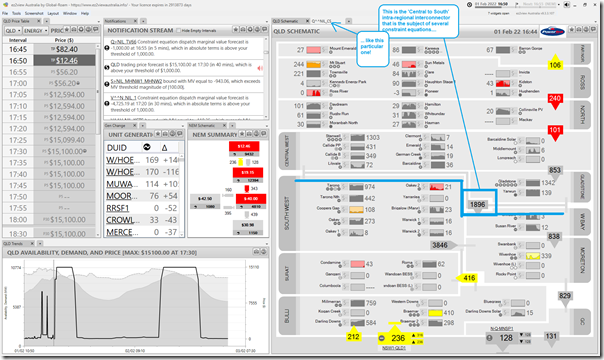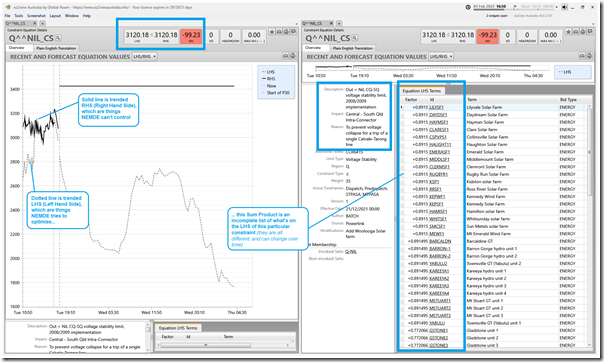I noted this afternoon, in the image about the Tarong unit 2 trip that the ‘Q^^NIL_CS’ constraint equation active, and contributing to market outcomes at times when it bound.
During the afternoon I followed on to start an explanation … but then was side-tracked by all the other activity. With it quietening down a little this evening, I thought it would be worth finishing off quickly, as this might be something that might be referred back to later.
So, for a start, here’s the snapshot from ez2view in the 16:50 dispatch interval:
The ‘Q^^NIL_CS’ constraint equation is the one that’s causing most of the DUIDs across the QLD region to flash with a positive or negative symbol.
1) I have made it a bit clearer with the blue annotations on the image above (click on the image for a bigger view).
2) Note that …
(a) many of the DUIDs above the central-to-south link are shown with a ‘+’ symbol … meaning they are on the Left Hand Side (LHS) of a bound constraint with a positive factor; and
(b) many of the DUIDs below the central-to-south link are shown with a ‘-’ symbol … meaning they are on the Left Hand Side (LHS) of a bound constraint with a negative factor; and
3) To understand what the ‘+’ and ‘-‘ means, we need to look at the form of the constraint, as shown in the window below:
… and in this case we see that the form of the constraint is ‘LHS ≤ RHS’ (which is very typical, except for FCAS constraints)
4) Because of this, we can understand that
(a) Anything with a positive factor (i.e. a ‘+’) will tend to be ‘constrained down’ by NEMDE when the constraint is bound …
… with with the degree of impact over all of the +ve DUIDs depending on their LHS Factor, and how each of them bid (i.e. Caveats).
(b) Conversely, anything with a negative factor (i.e. a ‘+’) will tend to be ‘constrained up’ by NEMDE when the constraint is bound
… with the same caveats applying
… and also the inverse happening if it is a Scheduled Load, like a battery charging
5) So the key take-away from the first image above is that the constraint will try to wind down output of generators above the line (i.e. in central and northern Queensland), and try to wind up generators in southern Queensland.
6) We can understand this when we read the purpose of the constraint is ‘To prevent voltage collapse for a trip of a single Calvale-Tarong line’
(a) reading from the constraint Reason, as provided by the AEMO in the EMMS, and shown in the ‘Constraint Details’ widget in ez2view as shown in the second image above; and
(b) remembering that the Calvale-Tarong link is the inland part of the aggregated Central-to-South flow (there is also a coastal route that forms the other part).
… so I won’t write any more about this today, but something to keep in mind in digging more deeply.




Leave a comment